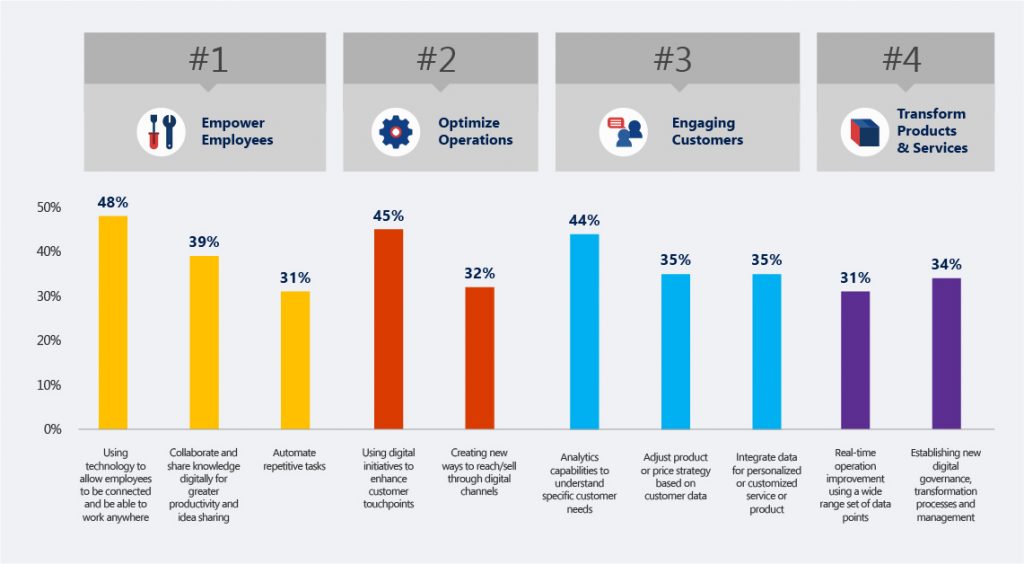
Inside India’s Digital Transformation Story
We stand on the brink of a technological revolution – the fourth industrial revolution.
Organizations are beginning to embrace new forms of digital transformation to remain relevant in the new dynamic. Around 88% business leaders in India polled in the Microsoft Asia Digital Transformation Study acknowledged that cloud computing is an essential part of their digital transformation strategy, and that the cloud has made it more affordable for companies of all sizes to embark on their digital transformation journey.
The big 5 tech trends for India
Powerful, purposeful and promising – 5 technologies are emerging as most relevant for India’s digital transformation via the cloud. These technologies will fundamentally alter the way we live, work, and relate to one another. In its scale, scope, and complexity, the transformation will be unlike anything humankind has experienced before.
 It is interesting to see that 87% of business leaders felt that new data insights would lead to new revenue streams – and acknowledge the need to transform. It is also concerning to see that they are doing so incrementally. The transformation is largely centered around empowering employees, engaging customers and optimizing operations. However, with constant pressure from newer, agile and tech savvy players disrupting across industries in Asia, the transformation of products and services, and new revenue models provides the greatest opportunity for organizations to truly lead rather than be disrupted.
It is interesting to see that 87% of business leaders felt that new data insights would lead to new revenue streams – and acknowledge the need to transform. It is also concerning to see that they are doing so incrementally. The transformation is largely centered around empowering employees, engaging customers and optimizing operations. However, with constant pressure from newer, agile and tech savvy players disrupting across industries in Asia, the transformation of products and services, and new revenue models provides the greatest opportunity for organizations to truly lead rather than be disrupted.
It is also important to note that while technologies like cloud and analytics, as well as AI and IoT, will give organizations new capabilities to transform – there are some challenges to make this transformation happen.
What challenges must India Inc. overcome for digital transformation?
The scope and scale for digital transformation in a country like India is clearly tremendous, as evidenced from the previous segment. Yet, the transformation isn’t keeping pace with the projected possibility. India has some way to go on the digital transformation journey. 40% of the business leaders surveyed believe that they have a full strategy in place and are well on their way to transforming their business. 53% are progressing in their digital transformation journeys, and 7% have a limited or no strategy today. Here are the top 5 challenges to their digital transformation as seen by India’s business leaders with the Microsoft Asia Digital Transformation Study.
Security
Digital transformation must be built on trust. People don’t use technology that they don’t trust. This is a golden rule that applies to organizations and individuals alike as we live in a mobile-first and cloud-first world. 64% of India respondents feel that the more an organization moves to the cloud, the less secure it is. Between today’s challenges and ones we haven’t yet imagined, a steady, consistent approach to security and privacy is essential to maintain and build customer trust.
Economy
An uncertain economic environment is a huge factor for digital transformation among businesses in India. Though business leaders in this study cited uncertain economic environment as a barrier to digital transformation, Microsoft advocates business leaders to apply greater urgency in transforming their organizations during times of volatility.
Workforce
Business leaders are concerned about the skill gap in their organizations especially when it comes to digitally-skilled workforce to optimize their digital businesses. While mobile data plans in India are among the cheapest in the world and the average retail price of smartphones are steadily declining, the Internet is still out of the reach of a sizable chunk of India’s population – which is a deterrent to creating a digitally-skilled workforce.
Policy
Lack of supporting governmental policies and ICT infrastructure to provide a sound digital transformation platform for organizations also emerged as a leading concern. Lack of organization leadership to ideate, plan and execute digital transformation also factored in the equation.
Cost
Another challenge unique to India, is the perceived cost of digital transformation. While the study revealed that the perceived costs of digital transformation was high, most India respondents (88%) in the study, also said that cloud computing and decreasing cost of devices have also made it more affordable for companies of all sizes to embark on a digital transformation journey.
Organizations that are not evolving how they operate or serve their customers will be less competitive or even obsolete as they face an unprecedented degree of disruptions in every industry. There has never been a time of greater promise, or greater peril. And as organizations negotiate their transformational journeys, there are key gaps in their expected outcomes and their current state of digital readiness.
How far along is India Inc. on its digital journey?
Although 92% of India Inc. believes that digital transformation is the future, only 37% of respondents in India have achieved or are on their way to achieving the desired outcomes of digital transformation. Overall, of the four pillars of digital transformation, organizations in India are adopting a people-first approach to their digital transformation strategy with empowering employees at 36% followed by optimizing operations at 26% – a trend that seems unique to selected Asia markets.
Empowering employees in terms of connecting them and enabling them to work and collaborate from anywhere is top of the mind at 48%. Surprisingly, automating repetitive tasks comes in at 31%.
The good news is that focus on customer centricity continues with analytics capabilities to understand specific customer needs at 44% and using digital initiatives to enhance customer touchpoints at 45%. Creating new digital channels for increasing customer reach and using analytics to adjust price points as well as provide personalization are also seen as key aspects.
Transforming products using data and digital technologies in order to create new revenue opportunities was the lowest ranked priority among business leaders today (31%). Yet, it is crucial to note that this transformation pillar provides the highest opportunity for organizations to truly disrupt their industries. While this is the most difficult digital transformation end goal for most organizations, this is also an area where we see newer, more agile players come in at a fast pace. Something big players should certainly take note of!
But who does India Inc. believe should drive digital transformation at the organization level? The CEO, the CTO, or possibly a Chief Digital Officer?
India Inc’s chief transformational officers
Can leadership be, both, an accelerator and a barrier to digital transformation? According to India Inc., yes.
Because, digitization is not just about technology. Even access to the best tech doesn’t ensure digital success. Companies must have the right mix of talent to lead and execute a successful transformation. Therefore, it is not surprising to see corporate leadership is cited, both, as an accelerator and barrier to digital transformation.
While CEOs are driving the digital transformation strategy in India’s organizations today – 31% as reported by the study, most respondents (35%) felt that Chief Digital Officers (CDOs) are the future drivers of digital transformation in the country.
Growing in importance – from 23% currently to 35% in the future (ahead of the overall Asia number at 27%) – the CDO’s role is now charged with leading and managing comprehensive changes that address everything from updating how a company works to building out entirely new businesses.
The study also revealed the rise of the CIO growing from 26% currently to 33% in the future.
The role of Chief Data Officer (CDO) as a leader of digital transformation, currently seems to be between 8-12% and is expected to remain static at a similar level in the future. This could be attributed to the fact that while recognition of data as a driver of digital transformation is on the rise, it is viewed as an integral part of the portfolio of the Chief Digital Officer, and not as a standalone function.
It’s interesting to note that 14% of the respondents in India felt that their digital transformation needs currently and in the future could be met by senior IT leadership (below C level) – while for the rest of Asia this figure stands at 11%.
As the digital age challenges the traditional organizational structure, these leaders of digital transformation must not only launch the organization on its digital trajectory but also help it fundamentally evolve. Those leaders that succeed, will truly have earned their place in the already-crowded C-suite.

















